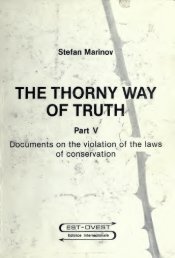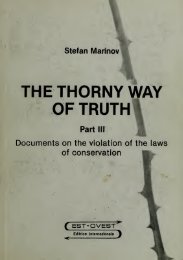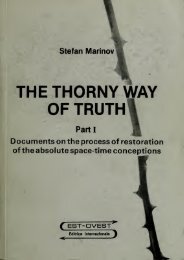The thorny way of truth - Free Energy Community
The thorny way of truth - Free Energy Community
The thorny way of truth - Free Energy Community
- No tags were found...
You also want an ePaper? Increase the reach of your titles
YUMPU automatically turns print PDFs into web optimized ePapers that Google loves.
- 27 0-STEFAN MA^NOVP'^o^- J- p- w^sieyMorellcnfddyasse Weiherdairmstr 16 20 June 1990.24A-8010 GRAZ - AUSTRIA D-7712 BlumbergTel. 0316/377093 Copy: P. T. PappasDear Paul,Thank you very much for your letter <strong>of</strong> the 14 June 1990.I shall publish your letters to me in TWT, only if they are written in a clear andDIDACTIC <strong>way</strong>, so that the reader can easily "enter" into the problem and pr<strong>of</strong>it <strong>of</strong> theexchange <strong>of</strong> our thoughts. I beg you to take seriously the publications in TWT as soon(because <strong>of</strong> the perpetual motion machines described there) TWT will be sold in thousands<strong>of</strong> copies.Unfortunately many aspects <strong>of</strong> your letters are not clear evenfor me, although I readyour writings with great attention.Now let me answer your letter <strong>of</strong> the 14 June.1. I sustain firmly the opinion that the word "electric tension" is to be introducedagain into the English scientific language and the word "voltage" is to be abandoned.Also the word "electromotive force" is to be abandoned and replaced by the word "electromotivetension". <strong>The</strong> symbol^ for electromotive force used at the present time (which,moreover, cannot by found in the typing machines nor distinguished by handwriting fromthe usual letter E) is to be replaced by the symbol U, with which I denote the quantity"electric tension". <strong>The</strong>re are different kinds <strong>of</strong> tension: electromotive tensions (chemical,inductive, piezoelectric etc.), ohmic tensions (when current flows along a wire)Coulomb tensions (between the plates <strong>of</strong> a condenser) etc. All <strong>of</strong> them are to be distin-jguished one from another, when appearing in the same context, by respective indices. Ishall follow this line in my writings hoping that after 100 years humanity will acceptMany scientists are unhappy with the word "electromotive FORCE", as "force" has completelydifferent sense and dimensions. Some recent authors use the term "electromotancewhich I consider also as bad.I beg you to take into account that these changes which I introduce in the terminolojare not linguistic but scientific.2. It is a pity that you did not wish to help me to calculate the pushing force onthe Ampere bridge by the help <strong>of</strong> Grassmann's formula when using your method with thecurrent densities.3. You object my assertion that the current density J along the portions 2 45 (and al:7&10) <strong>of</strong> your Ampere bridge on p. 173 <strong>of</strong> Sp.-T. Phys. 87 is not parallel to the distanar between the current elements <strong>of</strong> these portions. I repeat, when the cross-section <strong>of</strong>the wire is small I do not see how J can be not parallel to r.II do not understand your mathematics in the WHOLE Sect. II on p. 172 <strong>of</strong> Sp.-T. Phys. 1If you wish to help me, write and explain all mathematical calculations as to an under-fgraduate. I am your very SYMPATHETIC reader and I spent much time trying to understandand check your mathematics but I could not. Help me.4. <strong>The</strong> force on the Ampere bridge (with long enough legs) depends only on the currenjIt depends neither on the thickness <strong>of</strong> the wire, nor on the shape (form), nor on the sif<strong>The</strong> most easy pro<strong>of</strong> can be given for the shape: If the pushing forces on a n-form andU-form bridges will be different, then if making a very long rectangular loop endingon the one side by a U-form, the loop will be set into motion by internal forces. Simi-jlarly can be given the pro<strong>of</strong> that the force cannot depend on the thickness <strong>of</strong> the wire.]In TWT-VII, p. 165 I showed that the pushing force on a U-form bridge does not dependon the radius <strong>of</strong> curvature, i.e., on the size <strong>of</strong> the bridge. Many authors also have noticedthat the pushing force on the Ampere bridge depends only on the current and onNOTHING ELSE. For this reason I have dedicated too much time for trying to calculate ina mathematically exact <strong>way</strong> the pushing force on a U-form bridge, but I obtained only theresult that the force must by stronger than 0.3443 piN/A^. I do not abandon the effortsto obtain an EXACT number for this force and I beg you to help me.5. If the force on the Ampere bridge will be f = u N/A' in the system SI, it will be








